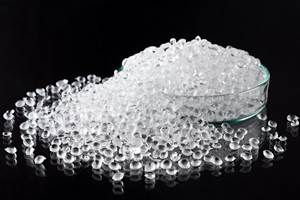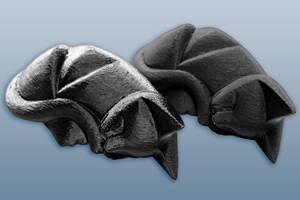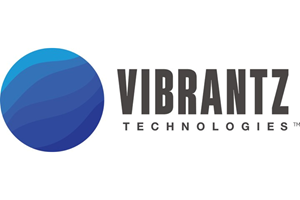White Mineral Oil A New Way to Lubricate Rigid PVC
Processors of rigid PVC pipe, window profiles, siding, fencing, and doors can save money and speed compound mixing by using a new grade of white mineral oil as an external lubricant in place of the usual paraffin wax.
Processors of rigid PVC pipe, window profiles, siding, fencing, and doors can save money and speed compound mixing by using a new grade of white mineral oil as an external lubricant in place of the usual paraffin wax. That's the word from Crompton Corp., Greenwich, Conn., whose Hydrobrite PVC Oil is a highly refined, free-flowing liquid paraffin that reportedly does not agglomerate in storage or handling as is typical of wax. The liquid form is also said to result in more uniform coating of PVC particles and improved productivity in high-intensity mixers. Hydrobrite is also believed to be slightly more compatible with PVC, which potentially could reduce plate-out. Most important, vinyl compounders can save up to 15% on lubricant cost with no sacrifice in performance, Crompton says.
Compared with paraffin wax, white mineral oil reportedly offers advantages of long-term price and supply stability. While there is no shortage of paraffin wax today, changes in petroleum production have reduced paraffin wax production in North America, and no new capacity is scheduled any time soon.
Performs like wax
This liquid lubricant has been approved by the Plastic Pipe Institute (PPI) and the National Sanitation Foundation (NSF) as a functional equivalent to paraffin wax for high-pressure PVC water pipe when used in range formulations at 1 to 2 phr. Chemically inert, colorless, odorless, and tasteless, it is also food grade (per 21 CFR 172.878 and 21 CFR 178.3620a) and boasts excellent uv and color stability.
As an external lubricant, the oil helps reduce friction between the polymer and metal surfaces and delays fusion of the PVC powder, just as wax does. To perform equivalently to 165 F paraffin wax, Hydrobrite PVC Oil must be used at up to 25% higher levels. However, lubricant cost savings of 6% to 15% can be achieved by switching to this alternative, as its cost is typically 25% to 36% lower than paraffin wax. One of the top North American PVC pipe producers reportedly saved over $300,000/yr by replacing paraffin wax with Hydrobrite PVC Oil.
Rheological data show Hy-drobrite to have processing characteristics similar to those of paraffin wax (see table). Crompton market manager Roy Seib points out that all rheology comparisons were done using 165 F paraffin wax, which used to be the workhorse product in the industry. However, availability constraints in recent years have forced many processors to use lower-melting paraffin waxes (140 to 158 F). Seib says that relative to these lower-melting waxes, the comparative use levels for Hydrobrite PVC Oil would be only 0% to 15% higher.
According to Seib, there is an insignificant reduction (about 1° C) in HDT when replacing paraffin wax with Hydrobrite oil. Hydrobrite also provides Izod impact test results equivalent to those obtained with paraffin wax.
Weathering characteristics of Hydrobrite oil also have been shown to be equivalent to wax. As shown in the accompanying graph, differences in color shift (E) for both white and dark-gray siding are negligible under accelerated weathering. Slightly improved performance with Hydrobrite in white siding can be attributed to the higher levels of lubricant, which causes less "wear and tear" on the polymer during processing.
Seib notes that Hydrobrite is used commercially in pressure pipe of 1.5 to 24 in. and larger diam., pressure fittings of 1.5 to 24 in., gravity-flow pipe of 8 to 24 in., gravity sewer pipe of 4 to 36 in., and other sewer pipe.
HYDROBRITE OIL VS. PARAFFIN WAX
IN TYPICAL NSF PVC PIPE COMPOUND 165 F
ParaffinHydrobrite
PVC OilUse level, phr 1.2 1.5 Fusion time, min 6:08 6:08 Initial fusion Torque, mg 1017 982 Torque at Fusion, mg 2098 2144 Equilibrium Torque, mg 1450 1450 Degradation Time, min 28:08 28:04
Related Content
K 2022 Additives & Materials: Sustainability in the Lead
Nearly all of the new additives highlighted at the big show are aimed at enhancing recyclability of commodity resins and some volume engineering resins such as nylon and PC. A few new materials, on which we had not previously reported, also surfaced at K 2022.
Read MoreUnderstanding the ‘Science’ of Color
And as with all sciences, there are fundamentals that must be considered to do color right. Here’s a helpful start.
Read MoreMasterbatches Reduce Gloss in PLA and PETG 3D Printed Products
Insight Polymers & Compounding’s two low-gloss additive masterbatches shown to boost appearance of 3D printed objects.
Read MoreVibrantz Technologies’ Leadership Changes
Formerly Chromaflo and Ferro, Vibrantz announces shifts in leadership roles.
Read MoreRead Next
How Polymer Melts in Single-Screw Extruders
Understanding how polymer melts in a single-screw extruder could help you optimize your screw design to eliminate defect-causing solid polymer fragments.
Read MorePeople 4.0 – How to Get Buy-In from Your Staff for Industry 4.0 Systems
Implementing a production monitoring system as the foundation of a ‘smart factory’ is about integrating people with new technology as much as it is about integrating machines and computers. Here are tips from a company that has gone through the process.
Read MoreUnderstanding Melting in Single-Screw Extruders
You can better visualize the melting process by “flipping” the observation point so that the barrel appears to be turning clockwise around a stationary screw.
Read More



























